Sphinginae subfamily
Sphingini tribe:
 |
This moth is a very strong flier, but would only make its way to
Chenango County as a rare stray.
Agrius cingulata is distinct
has bright pink abdominal 'ribs'.
|
 |
Ceratomia amyntor
WO,
the Elm Sphinx or Four-horned Sphinx
The upperside of the forewing is brown with dark brown and
white markings including a white costal area near the wing base,
dark streaks along the veins, and a white spot in the cell.
|
 |
The upperside of the forewing is pale brownish gray with wavy black
and white lines and a black-outlined white cell spot. The upperside
of the hindwing is gray with diffuse darker bands. |
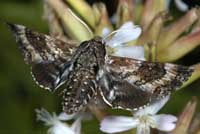 |
The upperside of the forewing is dark brown with a dusting of white scales. Some moths have patches
of reddish or yellowish brown on the wings.
|
 |
The upperside of the forewing is gray with heavy black bands. The
upperside of the hindwing is
brownish gray with no markings.
|
 |
The upperside of the forewing is gray-brown with wavy lines, black
dashes, and one or two small white spots near the center of the
costa. |
 |
Manduca quinquemaculatus
WO,
the Five-spotted Hawkmoth.
The moth abdomen usually has five but sometimes six pairs of yellow
bands. The upperside of the forewing is blurry brown and gray. The
upperside of the hindwing is banded with brown and white and has two
well-separated median zigzag bands.
|
 |
The abdomen usually has six pairs of yellow bands, broken across the back. The sixth set of markings is quite small.
The upperside of the forewing has indistinct black, brown, and white markings.
Larvae get very large and can strip a tomato plant.
|
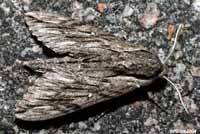 | The upperside of the forewing is gray with indistinct black and
white markings. There is a series of black dashes
from the base to the tip, and a small white cell spot. North of
normal range!
|
 |
Sphinx chersis
WO, the Northern Ash Sphinx or Great Ash Sphinx
This species might present but may not
be common. Larval hosts are ash, lilac, privet, cherry, and quaking aspen.
|
 |
Sphinx drupiferarum
WO, the
Wild Cherry Sphinx
Forewings, long and slender, are held close to the body when the
moth is at rest. We have them
on P.E.I., but I do not see them nearly as frequently
as I see the other Sphingidae.
|
 |
Sphinx gordius
WO,
Apple Sphinx:
Colouration & markings highly variable from one specimen to another. Fw fringes mostly black with some white; those on hw mostly white
with a few black patches.
Fw upperside ranges from brown with black borders through brownish gray with paler borders to pale gray with no borders.
Dashes, submarginal line, & cell spot usually weak.
|
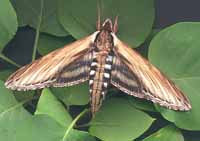 |
The lower forewings are predominantly brownish-yellow with a fairly
wide dark bar along the inner margin. At rest the wings hug the body,
giving the moth a long slender look.
|
 |
Sphinx luscitiosa
WO,
the Canadian Sphinx or
Clemen's Sphinx
The upperside of the forewing is yellowish gray in males and pale gray with a faint yellow tint in females. In both sexes, the dark border
on the outer margin widens as it approaches the inner margin.
|
 |
If you have blueberries in the woods, then you might have the
Poecila Sphinx. They are pretty common here on Prince Edward Island,
but don't fly too far south of Massachusetts, being replaced by
Sphinx gordius in Connecticut. Questionable for Chenango. |
Smerinthini Tribe:
 |
The adults are also highly variable; sometimes wings of an individual may be all one color or may have several colors, ranging from pale to dark brown, and may
have a white or pink tinge. Patterns range from faint to pronounced.
See the file for the female; she is different. |
 |
Pachysphinx modesta
WO,
the Modest Sphinx or Poplar Sphinx
This moth has a large, heavy body, and females can be
remarkably plump. Larvae feed on
poplars and willows. |
 |
Named for the dull grey-blue spot (minus dark pupil) in the hindwing,
this moth has a wide distribution and is probably common in your county.
I regularly see them on Prince Edward Island, and they are reported
as far south as Florida. |
 |
Named for the small eye-spot in the hindwing, this moth has a wide
distribution and is probably common in your county.
I regularly see them on Prince Edward Island, and they are reported
as far south as Florida.
|
 |
Your county would be close to the southern limit for this species in New York.
I never saw one in New Jersey. At my home in Montague, P.E.I., Canada, they are quite common. |
 |
This moth is widely distributed and fairly common.
Along the East Coast, it flies from P.E.I. to Florida. It probably
flies in your county. |
Macroglossinae subfamily
Dilophonotini tribe:
See Hemaris comparison to help distinguish
the next three species.
 |
Hemaris thysbe
WO, the Hummingbird Clearwing
This interesting day flier is reported in Cortland, and
is widely reported to the north, east, south and west.
They are widely distributed in the east from P.E.I. to Florida. |
 |
Hemaris diffinis
WO, the
Snowberry Clearwing or Bumblebee Moth
Adults mimic bumblebees and are quite variable, both geographically
and seasonally. The wings are basically clear, with dark brown to
brownish-orange veins, bases and edges.
The thorax is golden-brown to dark greenish-brown.
|
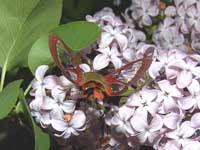 |
Hemaris gracilis WO, the
Slender Clearwing or Graceful Clearwing
Hemaris gracilis is distinguished from similar species by a pair of
red-brown bands on the undersides of the thorax, which varies from
green to yellow-green dorsally
and sometimes brown with white underneath.
|
Philampelini tribe:
 |
This moth is not reported for Chenango, but it is fairly often reported
along the coast from southern New Jersey
to central Maine.
Note the differences between this moth and the Pandorus Sphinx. |
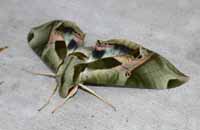 |
If you have Grape or Virginia Creeper nearby, then you probably have
this species.
I often get asked to identify larvae from areas not
previously reported. |
Macroglossini tribe:
 |
This day flier is widely distributed. If you have Virginia Creeper, you
probably have the Nessus Sphinx. Two bright, distinct, narrow yellow
bands are often visible on the abdomen.
|
 |
They are common in New Jersey and common
here on Prince Edward Island.
You will often see this species listed as Darapsa pholus,
especially in older literature.
It is not yet
confirmed for your county.
|
 |
Darapsa myron
WO, the Virginia Creeper Sphinx or the Grapevine Sphinx
This moth is not recorded for your county
It is widely reported as far north as southern Maine. If you have the
foodplants indicated in the common names, you probably have this
species nearby. |
 |
If you have hydrangea growing near a stream, then you may have the
Hydrangea Sphinx.
It has not been reported in Chenango, but likely
is present although uncommon.
|
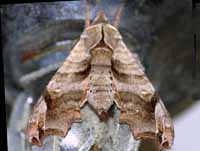 |
The moth's outer margin of the forewing is deeply scalloped.
The upperside is light brown with dark brown markings.
There is a small black and white spot near the tip.
The upperside of the hindwing is orange-brown with a
dark brown outer margin and median line.
|
 |
Hyles gallii
WO, the Bedstraw Hawk Moth
or Gallium Sphinx
This species is not confirmed in your county.
Some years I see them on P.E.I., some years, I do not.
|
 |
Hyles lineata
WO, the White-lined Sphinx
This species is reported from your county. It flies across
southern New York and has strong migrating tendancies.
There are records from New Hampshire and Maine. |
 |
This moth is very much under reported across the United States. It
is a rapid day flier so is probably not in too many collections.
Grape is a popular larval
|
|
|
